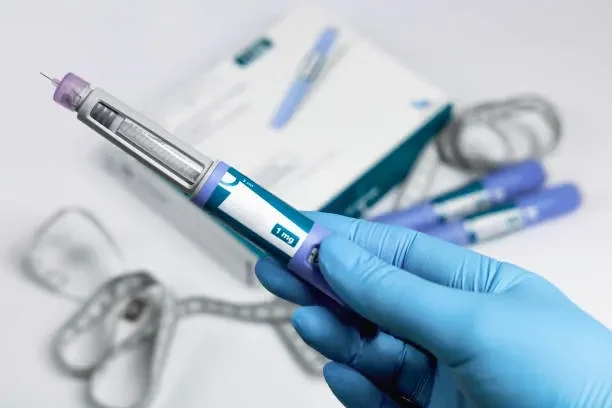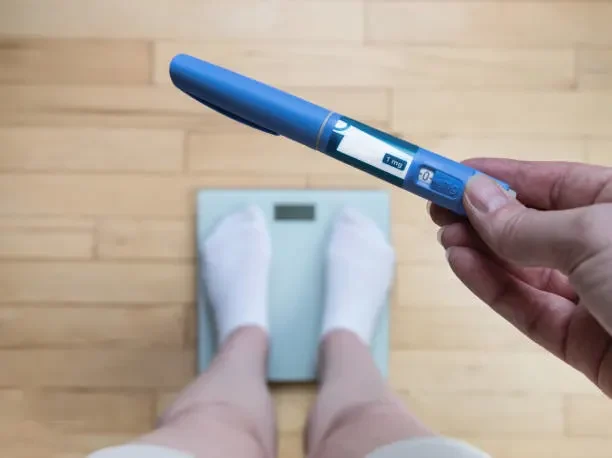Thinking About Ozempic for Weight Loss? Here’s What You Need to Know First....!!

In recent years, Ozempic for weight loss has become one of the most talked-about trends in the health and wellness space. The FDA granted the approval to Novo Nordisk (Danish multinational pharmaceutical company headquartered in Bagsværd) Semaglutide 1 mg injection (Ozempic) was first approved as a treatment for type 2 diabetes in 2017. Originally approved by the FDA as a treatment for type 2 diabetes, Ozempic (semaglutide) has shown a surprising side effect – substantial and sustained weight loss. This has led to a surge in interest, especially among people who have struggled with obesity or stubborn weight gain despite diet and exercise.
Although Ozempic is primarily prescribed to help control blood sugar levels in people with type 2 diabetes, many individuals are now turning to it off-label to aid in weight management. This medication works by mimicking hormones that regulate appetite, leading to reduced food intake and improved weight management.
If you’re wondering how to get prescribed Ozempic, you’re not alone. With its rapid rise in popularity, millions of people are now figuring out if they qualify for it and if it’s a safe and effective option for them. This guide will tell you everything you need to know – how it works, who it’s for, and how to talk to your doctor about it.
Let’s find out why Ozempic is more than just a diabetes medication – and how it could be a game-changer for your weight loss goals.
Table of Contents
What Is Ozempic and How Does It Work?

Ozempic is a brand name for semaglutide, a GLP-1 receptor agonist initially developed to manage type 2 diabetes. Recently, it has gained popularity for its effectiveness in weight loss, making it a topic of interest among health professionals and individuals looking for medical support in their weight management journey.
1. Explanation of Semaglutide (GLP-1 Receptor Agonist)
Semaglutide is a glucagon-like peptide-1 (GLP-1) receptor agonist, a class of drugs that mimic the GLP-1 hormone naturally produced in the gut. This hormone plays a key role in:
- Stimulating insulin release
- Reducing glucagon secretion
- Slowing gastric emptying
By activating the GLP-1 receptors, semaglutide helps regulate blood sugar levels, particularly after meals.
2. How It Helps Regulate Blood Sugar and Suppress Appetite
Ozempic works in two main ways:
Blood Sugar Control: It boosts insulin production and lowers glucagon, which helps keep blood glucose levels stable, especially in people with type 2 diabetes.
Appetite Suppression: One of the most talked-about effects of semaglutide is its ability to reduce hunger and increase satiety, helping users eat less and lose weight over time.
This appetite-suppressing effect is why semaglutide for weight loss has become a trending medical solution. Clinical studies have shown that patients using Ozempic can lose a significant amount of weight when combined with lifestyle changes like healthy eating and regular exercise.
Who Qualifies for an Ozempic Prescription for Weight Loss?

While Ozempic is FDA-approved for managing type 2 diabetes, it is increasingly prescribed off-label for weight loss due to its proven appetite-suppressing effects. However, not everyone qualifies for this treatment. Here’s what you need to know about Ozempic eligibility and prescription criteria.
1. BMI Eligibility: ≥30 (Obese), or ≥27 With Comorbidities
To meet typical Ozempic prescription requirements for weight loss, individuals generally need to fall into one of these BMI categories:
BMI ≥30: This qualifies as obesity.
BMI ≥27: with weight-related health conditions, such as:
- Type 2 diabetes
- High blood pressure (hypertension)
- High cholesterol
- Obstructive sleep apnea
These thresholds are in line with how similar medications (like Wegovy, another semaglutide brand) are approved for weight loss.
2. Underlying Conditions That Support Eligibility
Even without a formal weight-loss drug approval, doctors may consider Ozempic for patients struggling with:
- Type 2 Diabetes (its primary FDA-approved use)
- Polycystic Ovary Syndrome (PCOS)
- Metabolic syndrome
- Hypertension or insulin resistance
These conditions increase the risks associated with obesity and support the use of Ozempic for weight loss under medical supervision.
3. FDA Status & Off-Label Use Disclaimer
Ozempic is not FDA-approved specifically for weight loss—that distinction belongs to Wegovy, which contains a higher dose of semaglutide. However, many healthcare providers prescribe Ozempic off-label for weight loss, especially when:
- Wegovy is not available or too expensive
- The patient responds well to lower doses of semaglutide
Important: Off-label use should always be discussed with a licensed medical professional. They will evaluate your overall health and determine if Ozempic is appropriate based on clinical guidelines and personal risk factors.
How to Get Prescribed Ozempic (Step-by-Step)

If you’re considering Ozempic for weight loss or type 2 diabetes management, it’s important to understand the Ozempic prescription process and how to navigate medical and insurance requirements. Here’s a step-by-step guide:
Step 1: Consult Your Doctor or a Telehealth Provider
Start by booking an appointment with a primary care physician, endocrinologist, or licensed telehealth provider. They will evaluate whether Ozempic is suitable based on your BMI, health conditions, and medication history.
Step 2: Discuss Your Weight History and Attempts at Weight Loss
Be prepared to discuss:
- Your weight journey
- Past diet or fitness efforts
- Related health issues (e.g., PCOS, insulin resistance)
Step 3: Undergo Necessary Lab Tests or Evaluations
Your doctor may order tests such as:
- Blood glucose or A1C (to assess insulin resistance or diabetes)
- Lipid profile
- Liver and kidney function tests
These ensure that Ozempic is safe for you and may also support the insurance approval process.
How to Get Ozempic Covered by Insurance
Coverage for Ozempic varies by insurer and whether it’s prescribed for type 2 diabetes (approved use) or weight loss (off-label use). Here’s how to improve your chances of insurance approval:
- Get a documented diagnosis (e.g., type 2 diabetes, obesity, PCOS)
- Ask your doctor to submit prior authorization to the insurance provider
- Check formulary lists to see if Ozempic is included under your plan
- Appeal denials with medical justification if needed
Cost and Insurance Coverage
The cost of Ozempic can vary significantly:
- Without Insurance: Approximately $850–$969 per month.
- With Insurance: Coverage may be limited, especially for off-label use. Some insurance plans may require documentation of previous weight loss attempts or additional health conditions to approve coverage.
- Financial Assistance: Novo Nordisk offers co-pay assistance programs for eligible individuals with commercial insurance.
Step 4: Get Started With a Dosage Plan
If you’re approved, your provider will prescribe an appropriate starting dose—usually 0.25 mg weekly, increasing gradually to manage side effects. You’ll also receive guidance on:
- How to inject Ozempic
- Possible side effects
- Follow-up visits
Ozempic Dosage and How to Use It

Understanding the proper Ozempic dosing schedule and injection method is key to safely and effectively using the medication—whether for managing type 2 diabetes or off-label weight loss. Here’s everything you need to know about starting and using Ozempic correctly.
1. Starting Doses and Titration Schedule
Ozempic is a once-weekly injectable medication. The starting dose is low to minimize side effects such as nausea, and it increases gradually over time.
Typical Ozempic dosing schedule:
- Week 1–4: 0.25 mg once weekly (starter dose, not for blood sugar control)
- Week 5–8: 0.5 mg once weekly
- Optional increase (if needed):
- 1.0 mg once weekly
- Up to 2.0 mg once weekly (maximum dose, based on provider’s judgment)
Note: Always follow your healthcare provider’s instructions for dosage increases. Titration helps reduce gastrointestinal side effects and allows your body to adjust.
2. Weekly Injection Instructions
Follow these basic steps from the Ozempic injection guide:
- Frequency: Inject once a week, on the same day each week (e.g., every Monday).
- Time of Day: Any time—morning or evening, with or without food.
- Injection Sites: Upper arm, thigh, or abdomen (rotate spots weekly to avoid irritation).
- How to Inject:
- Wash your hands and clean the injection site.
- Attach a new needle to the pen.
- Set your dose using the dose selector.
- Insert the needle under the skin and press the injection button fully.
- Hold for 5–10 seconds to ensure full delivery, then remove and dispose of the needle safely.
Note: Keep your Ozempic pen refrigerated before first use. Once opened, it can be stored at room temperature (below 86°F or 30°C) for up to 56 days.
3. Tips for Safe Usage
- Don’t skip doses: If you miss your dose, take it within 5 days. Otherwise, wait for the next scheduled dose.
- Avoid alcohol and high-fat meals: These may worsen side effects like nausea.
- Stay hydrated: Especially in the first few weeks, as Ozempic may cause mild dehydration.
- Report severe side effects: Such as persistent vomiting, signs of pancreatitis, or vision changes.
Note: Never share your Ozempic pen—even if the needle is changed.
Side Effects and Safety Considerations

As with any prescription medication, Ozempic comes with potential risks and side effects. Whether you’re using it for type 2 diabetes or weight loss, it’s essential to understand the safety profile before starting treatment. Here’s what to know about Ozempic side effects for weight loss and overall safety concerns.
1. Common Side Effects
Many people experience mild to moderate side effects when starting Ozempic, especially during the first few weeks of treatment. These include:
- Nausea (most common)
- Constipation or diarrhea
- Fatigue
- Loss of appetite
- Bloating or indigestion
- Mild injection site reactions
Note: These side effects often lessen over time as your body adjusts to the medication. Starting with a low dose and following the titration schedule helps reduce symptoms.
2. Warnings: Thyroid Tumors & Pancreatitis
While Ozempic is generally safe when used as prescribed, it carries serious warnings for certain rare but serious conditions:
- Thyroid C-cell tumors: In animal studies, semaglutide (the active ingredient) has been linked to thyroid tumors, including medullary thyroid carcinoma (MTC). Though rare in humans, this risk has led to a boxed warning.
- Pancreatitis: There is a potential risk of inflammation of the pancreas, which can cause severe abdominal pain and may require medical attention.
Other warnings include:
- Gallbladder issues (e.g., gallstones)
- Hypoglycemia (especially if combined with insulin or sulfonylureas)
- Kidney problems due to dehydration from nausea or vomiting
Important: Is Ozempic safe? For most people, yes—when used under medical supervision. However, the above risks should be discussed thoroughly with your healthcare provider before beginning treatment.
3. Who Should Not Use Ozempic
Ozempic may not be safe or recommended for certain individuals. You should not use Ozempic if:
- You have a personal or family history of medullary thyroid carcinoma (MTC)
- You have Multiple Endocrine Neoplasia syndrome type 2 (MEN 2)
- You’ve previously had pancreatitis
- You are pregnant or planning to become pregnant
- You are breastfeeding
- You are allergic to semaglutide or any of its ingredients
Note: Always inform your doctor about your full medical history and current medications to avoid complications or dangerous interactions.
Alternatives to Ozempic

While Ozempic is a popular option for blood sugar management and off-label weight loss, several FDA-approved or clinically promising alternatives are available. If you’re exploring options, here’s how Wegovy, Mounjaro, and Saxenda compare in terms of effectiveness, dosing, and cost.
1. Wegovy (Semaglutide)
Wegovy contains the same active ingredient as Ozempic—semaglutide—but is FDA-approved specifically for chronic weight management in adults with obesity or weight-related conditions.
- Dose: Higher than Ozempic (up to 2.4 mg weekly)
- FDA status: Approved for weight loss
- Effectiveness: On average, patients lose 15% of body weight
- Insurance coverage: More likely for weight loss than Ozempic
- Cost: ~$1,300/month without insurance
🔍 Wegovy vs Ozempic: Wegovy is better suited for weight loss due to its higher dose and formal approval, while Ozempic is primarily for diabetes (but often used off-label for weight reduction).
2. Mounjaro (Tirzepatide)
Mounjaro is a newer medication that acts on both GLP-1 and GIP receptors, offering dual hormone action for more substantial weight loss and blood sugar control.
- Dose: Starts at 2.5 mg, up to 15 mg weekly
- FDA status: Approved for type 2 diabetes; under review for weight loss
- Effectiveness: Up to 20% weight loss in clinical trials
- Cost: ~$1,100–$1,300/month without insurance
- Insurance: Coverage varies; more likely approved for diabetes patients
Note: Mounjaro for weight loss has shown greater results than Ozempic or Wegovy in clinical studies, but it’s currently approved only for type 2 diabetes (as of now).
3. Saxenda (Liraglutide)
Saxenda is a daily injectable GLP-1 receptor agonist like semaglutide but with a shorter duration of action.
- Dose: 3 mg injected daily
- FDA status: Approved for weight loss
- Effectiveness: ~5–10% weight loss
- Cost: ~$1,300/month
- Insurance: May be covered if BMI criteria are met
Note: Saxenda requires daily injections and typically offers more modest weight loss results compared to weekly options like Ozempic or Wegovy.
Summary Table: GLP-1 Weight Loss Medications
| Medication | Active Ingredient | FDA-Approved for Weight Loss | Avg. Weight Loss | Frequency | Est. Cost |
|---|---|---|---|---|---|
| Ozempic | Semaglutide | ❌ (off-label) | ~10–15% | Weekly | $900–$1,200 |
| Wegovy | Semaglutide | ✅ | ~15% | Weekly | ~$1,300 |
| Mounjaro | Tirzepatide | ❌ (pending) | ~15–20% | Weekly | ~$1,300 |
| Saxenda | Liraglutide | ✅ | ~5–10% | Daily | ~$1,300 |
Conclusion

Ozempic has emerged as a powerful tool for managing type 2 diabetes and aiding weight loss—especially in individuals who struggle with obesity-related health conditions. While it’s not FDA-approved specifically for weight loss, many patients are seeing real results under medical supervision. If you’re considering Ozempic, understanding how it works, who qualifies, and how to use it safely is essential.
There are also several alternatives like Wegovy, Mounjaro, and Saxenda, each with its own benefits, costs, and approval status. Speak with your healthcare provider or a licensed telehealth specialist to determine the best treatment option for your personal health goals.
Always prioritize safety, stay informed, and follow a comprehensive plan that includes healthy eating, exercise, and regular monitoring.
🔗 Related Articles You’ll Find Helpful:
Best Morning Routine for Weight Loss in 2025 (Scientifically Proven)
7-Day Diet Plan for Weight Loss (2025) – Easy & Effective (Burn 1200–1500 Calories Per Day)
Frequently Asked Questions (FAQs)
Is Ozempic FDA-approved for weight loss?
No. As of now, Ozempic is FDA-approved for type 2 diabetes, but it is often prescribed off-label for weight loss. Its counterpart, Wegovy, which contains the same active ingredient (semaglutide), is FDA-approved specifically for weight management.
Can I get Ozempic online?
Yes, several telehealth services offer consultations with licensed healthcare professionals who can assess your eligibility and prescribe Ozempic if appropriate. However, a legitimate prescription is always required.
What’s the difference between Ozempic and Wegovy?
Both contain semaglutide, but Wegovy is formulated and approved for chronic weight management at a higher dose, whereas Ozempic is approved for diabetes management.
How long does it take to see weight loss results with Ozempic?
Most people begin noticing weight loss within the first 8 to 12 weeks, especially when combined with diet and exercise.
Is Ozempic safe for long-term use?
Early data suggest it can be used long-term under supervision, but risks like pancreatitis, gallstones, and thyroid issues may occur. Regular monitoring by a healthcare provider is essential.

